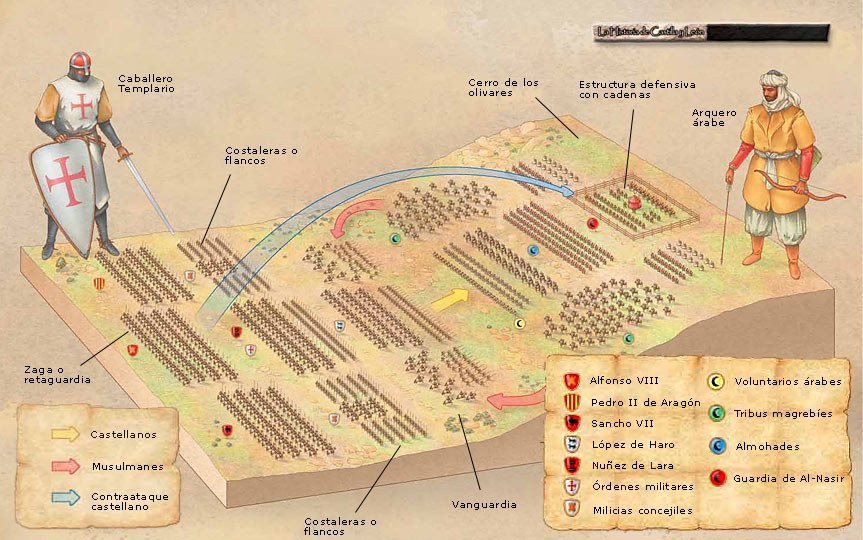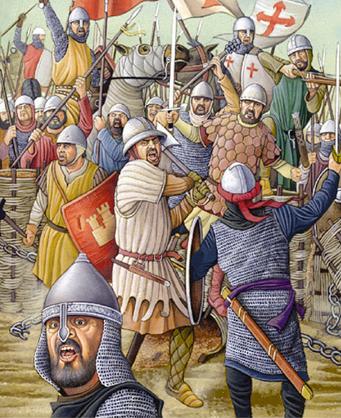The Chess Board is Set Up. White move first.
“God has numbered the days of your reign and brought it to an end; You had been weighed and found wanting; Your kingdom will be divided and given away”. Book of Daniel, 5:25
The year of the Lord 1211
When the year start, both Philip Augustus and John Lackland prepare to fight against each other once again, as the truce will end in September. Both count theirs friends and enemies.
Philips know that aside of the direct territories controlled by him, he can also count on Brittany and Artois, Burgundy, Champagne (well, most of it), Blois, Dreux, Montfort, Auxerre and Tonnerre (controlled by his relative Pierre of Courtenay), Sancerre and Bourbon. The most delicate issue remains the Flemish one. The young Joan, countess of Flanders and Hainault, was in his control and betrothed to his cousin Pierre of Dreux, but she do not have any real control on the counties as everybody, from nobles to town’s bourgeoisie, reject her rule on the grounds of being French puppet. He knows that the Aquitanian nobles were not very trusty and they submitted only formal to him. Concerning the external allies, Philip could count only the claimant of the Imperial throne, the 17 year old Frederick Hohenstaufen king of Sicily and, ally of convenience, the Sanctity Pope Innocent III, now in struggle with John.
On the other hand, John can trust his money. Money that could rise a mighty army, pay a strong fleet and fuel his external alliances. While he had strong external allies, he do not have many internal ones. The barons despise him especially for his cowardice in battle but John was decided to change his nicknames from Softsword to Strongsword. He start the year with a series of lighting campaigns against Scots, Welsh and Irish.
Sadly, the historians tends to not give the right importance to his victories, as well as to John management qualities. Those are perhaps the greatest injustices made to this king.
In one single year (well, he start on previous one), John crushed the Scots in a succession of battles and took many of their castles on the southern border, captured their king William and force him to pay homage for the entire kingdom of Scotland and pay 10.000 marks. He repaired the damage made by the mighty praised Richard Lionhart who had sell his feudal right on Scotland established by his father for 10.000 marks, sum that he obtained it back.
With the Treaty of Falaise resurrected. John marched against the rebellious Llywelyn the Great, Prince of Gwynedd and de facto ruler over most of Wales. This was both a military victory and a political one. The prince was forced to accept the royal authority over most of his lands and pay homage to John, who used the marcher lords to kip the Welsh contained.
After this victory, John crossed the Irish Sea with more than 1000 knight and many foot soldiers and crush the rebellion, establishing once again his control over all of Ireland. He named Hugue of Lacy, freshly returned from crusade, as his Justiciar and enforce upon the Irish and Anglo-Norman barons a charter to order compliance with English laws and customs.
Troubles in Flanders - A false Baldwin?
In the beginning of the summer of 1211, Philip Augustus make the move that was cataloged by the historians as the start of the troubles. On the Sunday of 5 June, in Lille, the wedding between 24 years old Pierre of Dreux and 17 years old Joan was lavishly celebrated, but the ambiance was tense as most of the Flemish barons refuse to participate.
Soon after, in Gand, a popular revolt besiege the count loyal garrison inside the castle. When a relief force, make mostly from French troops arrived to the city and put it to the siege, a general revolt followed. Nobles and citizens rally to the banners of a strange man. A man who just arrived and declared the he was Baldwin, the true count and former Emperor of Constantinople, who had survived from the Battle of Adrianople and returned to retake his lands. He was meet with such popular enthusiasm that nobody bother to ask him about delicate and private details like from where he had so much money...
The French army in Flanders was slaughter and very quick the entire region was completely out of French control. The single loyal remaining city was Lille, who was quickly fortified and the garrison strengthen. Soon, the Emperor Otto IV sent envoy to recognise Baldwin as rightful count of Hainaut (fief of the Empire) and Flanders, as well as did John. Baldwin pay homage to John for Flanders and to Otto for Hainaut and expected help, help materialized by a force of English mercenaries arrived at Dames and lead by nobody than William Longsword, half-brother of the King of England.
The King Trial
In reaction, the King Philip Augustus call the Baron Assembly. He invite the self-declared Baldwin to come to the assembly in order to be questioned about the identity and to be recognized as he was really was. He publicly accused John for truce braking. Also, John received a summon to be judged for his crimes.
The Barons of France gather at Amiens on the 29 August, the feast of martyrdom of Saint John the Baptist. Recently Amiens acquired a tremendous important relic, brought by Wallon de Sarton from Constantinople after the sack of the city – the head of the Saint John. The chosen date and place were highly symbolic. Of course, neither Jon nor Baldwin were presents. After the mass, the barons gather for the John trial. John was formally accused for murdering Arthur of Brittany and disobeying the King call as his vassal. In the witness stand was William de Braose, a man who once was John the most trusting man.
De Braose related to everybody what happened to Arthur and swear that John had killed his nephew with his own hands, being drank on the Thursday before Ester in 1204. The details stunned the nobility of France who, in unanimity, declared John forfeit of his all properties and titles, including the throne of England. As an excommunicated felon and murderer, he will be disposed and the throne of England will be awarded to Prince Louis, Duke of Brittany, by right of his wife, the true heiress of the Kingdom.
The second item on the list was Baldwin case. As he was not present, refusing to summon at the king call and paying homage to an accursed king, enemy of the Church and of the Kingdom, he is not the true Baldwin and so the rightful count is Joan.
The barons swear to help these two injustices to be punish and to defend their King against his enemies. A papal legate confirm the disposition against John and right of Prince Louis to the throne. Even more, he promised a crusade against the excommunicated king, a "tyrant who committed disgraceful crimes", mandating Philip and Louis to organizing and leading it.
With the same occasion, the King and the recently elected Bishop of Amiens, Évrard de Fouilloy, give a charter to rebuild the Cathedral in the same fashion as the one built in Paris, dedicated to Saint John the Baptist[1]. From now the Amiens become an important place of pilgrimage for the entire Christendom.
The King of England receive a formal letter announcing his trial and condemnation. The letter start with the scripture passage: “Mene, Mene, Tekel, uPharsin”.
A Royal army was sent to Gascony to put in place the decision of confiscation. The Gascons lords were in doubt. What they prefer the most? An absent and far away king-duke, even if incompetent and malicious, or a strong and more closely king with great prestige, acting rightfully, but maybe not so willing to let them to do whatever they pleased? For the moment they prefers to stay apart and watch.
Rumors start to spread that John had sent a diplomatic mission formed by the King’s men Thomas of Erdington and Ralph fiz Nicolas and the royal clerk Robert of London[2] to Mohammed al-Nasir, the emir of Morocco with the instruction of paying homage to him and offer John conversion to Islam in exchange of protection, but the emir was so disgusted about the proposal than he rejected it with anger. As the historians later clarified, the mission was real but the purpose was to sign some commercial treaties, nothing more. It was another example of Capetian propaganda, helped by the “battalions of hostile monks”][3].
----------------
Main Sources:
Wikipedia
“The Household Knights of King John” by S. D. Church
“Blood Cries Afar: The Forgotten Invasion of England 1216” by Sean McGlynn
"La condamnation de Jean Sans-Terre par les pairs de France" by Paul Guilhiermoz and Charles Bémont
---
[1] The Cathedral of Amiens start to be built in Gothic stile in 1220 by the same Évrard de Fouilloy
[2] From “The Household Knights of King John” by S. D. Church
][3] From “Blood Cries Afar: The Forgotten Invasion of England 1216” by Sean McGlynn
Last edited:

